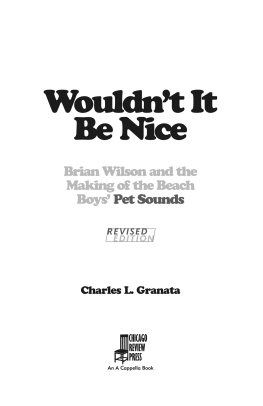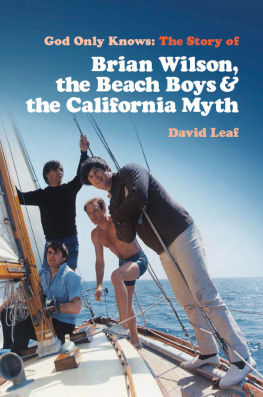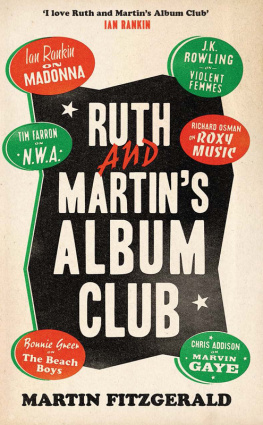Copyright 2017 by Charles L. Granata
All rights reserved
Published by Chicago Review Press Incorporated
814 North Franklin Street
Chicago, Illinois 60610
Note: Every effort has been made to contact copyright holders.
The editor would be pleased to hear from any copyright holders
not acknowledged .
introduction
to the revised edition
Relatively few artistic endeavors remain relevant or continue to thrive after fifty years. New styles and trends inevitably nudge formerly vaunted works to the background andoftentimesinto obscurity. Nowhere is this more prevalent than in music: our most widely distributed and easily disposable art form. Although a good number of genres that developed during pop musics greatest period have survived (the British Invasion and Motown, for example), for every artist and musical form that has endured over the last half century, at least a hundred have probably disappeared.
Think of the millions of original records that were created during the span of sound-recording history. Of that staggering number, only several dozen full-length albums would really merit a place on a meaningful list of mind-expanding, iconic recordsones that represent significant changes in music and pop culture. Of those few, one in particular is separated from all the others by virtue of its enigmatic existence: the Beach Boys Pet Sounds.
Like a premature baby, Pet Sounds was among the unlikeliest of records to distinguish itself from the rest: miraculously recovering from its tenuous birth to flourish and becomefifty years after its creationthe widely acknowledged Number One Album of All-Time.
For years, Pet Sounds was considered one of Brian Wilson and the Beach Boys strangest projectsan LP that went from the front rack to the cutout bin almost as soon as it was released. By the time I wrote this book in 2003, the worlds perception of Pet Sounds had gone from cult classic to landmark achievement. One couldnt ask for more praise than what was generously heaped on Brian and the album on its thirtieth anniversary in 1996. But astonishingly, here we are twenty years later, and the plaudits keep coming. Its unlikely that theyll ever stop. In addition to a new Pet Sounds tour, Brian and his trusted engineerMark Linetthave prepared a new fiftieth anniversary box set. And at least two tribute albums featuring interpretations by a variety of contemporary artists and bandseach re-creating the original sequencing of the albumhave been released during the last year. Interest in the album continues, unabated, and that both pleases and surprises me.
I wrote this book because of my love for the music on Pet Sounds and for its creator. As a youngster, these recordings affected me emotionally: they raised the hair on the back of my neck, gave me goose bumps, and, yes, made me well up with tears. When I was in my late thirties I rediscovered Pet Sounds and realized that while much of my attraction to it was rooted in the warm memories it inspired, the emotion behind the music had never changed. Time, place, and age didnt matter; I was just listening from a new perspective. Each subsequent listen (and there have been many) continues to reveal subtleties I somehow missed all the times before.
Another reason for the book was that I was eager to share with others my thoughts about why these songs move me the way they do, and what I heard in them. I believed that by interviewing the key participants, I could wring out every last detail behind the albums creation and explain some of the mystique and reasoning behind its gut-wrenching notes, chords, and lyrics. The story quickly turned into a who, what, where, how, when, and why kind of tale that offered what Id hoped would be the definitive source on the making of the record.
Yes, I had read the liner notes in David Leafs magnificent thirtieth anniversary box setand have acknowledged how inspirational they were. While the interviews included in that package were insightful, I found their unedited stream-of-consciousness presentation disjointed. As an inquisitive music historian who had conducted scores of interviews with major figures in the pop music and recording world, I felt myself yearning to ask follow-up questions to their answers. As a reader, I wanted greater detail. And so, when Chicago Review Press editor Yuval Taylor asked if Id like to write about the making of Pet Sounds, the immediate answer was yes.
I conducted fresh interviews and engaged the assistance of lyricist Tony Asher: the one person who knew more than anyone, except Brian himself, about how Pet Sounds was conceived and created. I also spoke with all of the surviving Beach Boys, except for Brian (a conscientious and well-reasoned decision on my part, despite the fact that I had an open invitation to do so). I studied and analyzed every second of the sessions and the final albumboth the mono and stereo mixes. When I felt that I had the information necessary to tell a cohesive story, I wrote ithoping that it would move at least a handful of people to listen to Brians music (Pet Sounds specifically) in a different way.
While many people praised the original edition of this book, I felt that my explanations somehow fell a bit short. I didnt think that Id been able to definitively pinpoint and articulate why this music touches us so deeplyand why those of us who love Brian and his music keep coming back to these songs again and again. I realized that while I had some musical training and an abundance of musical and technical knowledge, I lacked the lexicon to translate my deepest thoughts and feelings about this music to the pages of a book.
Everything opened up for me in 2006 when a good friend and collaboratorlegendary record producer Phil Ramonegave me a copy of Dr. Daniel J. Levitins book This Is Your Brain on Music. In his study, Dr. Levitin (a musician, record producer, and neuroscientist) delves into the power of music and how it becomes embedded in our brains. His clear, concise scientific explanations wiped away the clouds and helped me understand that in my zeal to document the writing and recording of Pet Sounds, Id completely overlooked a critical factor in explaining why one is so moved by its beauty: the role of our brains in assimilating, processing, and storing music.










